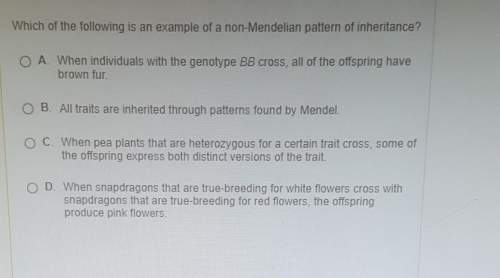
Biology, 12.10.2019 10:00 reinabrooke
Aroot is absorbing water from the soil. which route will the water travel inside the root? a. cambium --> phloem --> xylem --> stele --> endodermis --> cortex --> epidermis/// b. xylem --> phloem --> endodermis --> stele --> epidermis --> cortex --> cambium ///c. epidermis --> cortex --> endodermis --> stele --> xylem --> phloem --> cambium

Answers: 2
Another question on Biology

Biology, 21.06.2019 15:00
If someone could do the first couple, just so i can see how it's done that would be great! 20 points. complete a dichotomous key for the 10 leaves on the common leaves sheet. the chart provided here allows for 11 pairs of statements. depending on how you build your dichotomous key, you may or may not need all of them, or you may need to add some.
Answers: 2

Biology, 21.06.2019 16:00
Match the digestive enzymes to the macro molecules they to digest. down fats into glycerol and fatty acids down carbohydrates into simple sugars down nucleic acids into nitrogenous bases and simple sugars down proteins into amino acids
Answers: 1

Biology, 21.06.2019 17:00
In tossing one coin 10 times, what are your chances for tossing a head? a tail? 2. in tossing one coin 100 times, what are your chances for tossing a head? a tail? 3. in tossing one coin 200 times, what are your chances for tossing a head? a tail? deviation = ((absolute value of the difference between expected heads and observed heads) + (absolute value of the difference between expected tails and observed tails)) divided by total number of tosses. this value should always be positive. 4. what is the deviation for 10 tosses? 5. what is the deviation for the 100 tosses? 6. what is the deviation for 200 tosses? 7. how does increasing the total number of coin tosses from 10 to 100 affect the deviation? 8. how does increasing the total number of tosses from 100 to 200 affect the deviation? 9. what two important probability principles were established in this exercise? 10. the percent of occurrence is the obtained results divided by the total tosses and multiplied by 100%. toss the coins 100 times and record your results. calculate the percent occurrence for each combination. percent head-head occurrence: percent tail-tail occurrence: percent head-tail occurrence:
Answers: 1

Biology, 22.06.2019 01:50
It is believed that europa, one of jupiter’s moons has an ocean beneath its surface. based on how earth’s oceans and atmosphere are believed to have formed, what can be said about europa’s supposed ocean? the arrival of in the early days of europa’s existence could have formed its ocean. it is likely that the water experienced , similar to earth. it is also possible that this water is retained beneath europa’s surface and in its atmosphere due to europa’s .
Answers: 1
You know the right answer?
Aroot is absorbing water from the soil. which route will the water travel inside the root? a. cambi...
Questions



Mathematics, 24.03.2020 00:12


Computers and Technology, 24.03.2020 00:12


History, 24.03.2020 00:12



Mathematics, 24.03.2020 00:12

Mathematics, 24.03.2020 00:12





Mathematics, 24.03.2020 00:13




Mathematics, 24.03.2020 00:13




